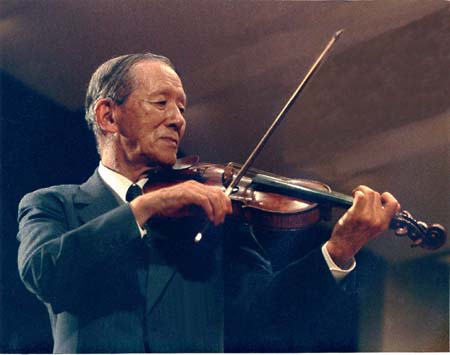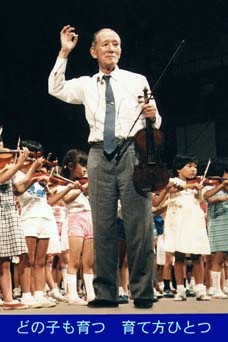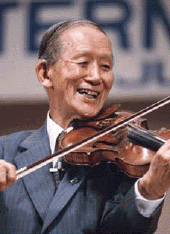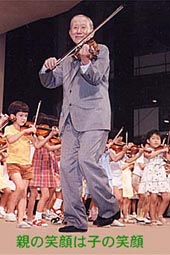
Web Site: http://DomRep-Suzuki-Violin.tripod.com Tel: (809) 574-6117
E-Mail: Suzuki.Violin.Dominican.Rep@usa.net Cell: (809) 440-5024

Web Site:
http://DomRep-Suzuki-Violin.tripod.com Tel: (809) 574-6117
E-Mail:
Suzuki.Violin.Dominican.Rep@usa.net
Cell: (809) 440-5024
DR. SHINICHI SUZUKI
Founder of Suzuki Method

The life and times of Dr. Shinichi Suzuki can be best summed up by the article,
"Dr. Shinichi Suzuki & his Talent Education", written by Nicolette
Solomon of the Suzuki Institute of Dallas.. She writes:
 "The musical and educational world was taken by storm in the 1950's when a
young Japanese violinist named Shinichi Suzuki toured Japan and later, America
with a group of very small Japanese children, all playing the violin. Every
performance was followed by an impassioned talk, given by this experimental
teacher, on the talent in all children. He spoke on the gift of "life force:
that is hidden in each one of us and the vital
importance of nurturing, unconditional love and the provision of an environment
for all children where their talent and love of life can
thrive."
"The musical and educational world was taken by storm in the 1950's when a
young Japanese violinist named Shinichi Suzuki toured Japan and later, America
with a group of very small Japanese children, all playing the violin. Every
performance was followed by an impassioned talk, given by this experimental
teacher, on the talent in all children. He spoke on the gift of "life force:
that is hidden in each one of us and the vital
importance of nurturing, unconditional love and the provision of an environment
for all children where their talent and love of life can
thrive."

Quoting Dr. Suzuki, she goes on to write: "Children all over the world were
speaking in their own language; moreover, they were doing it fluently, which
requires a very high level of proficiency. I started to study and observe the
practicability of the "Mother-Tongue: method. I adapted this to music
education."
Nicolette Solomon continues: "The world took notice, albeit skeptically. Who
was this Japanese man whose culture had no history of Western music, let alone
violin playing? Every once in a long while, a genius is born and Suzuki was one
of a kind, ever-learning individuals. His friends included people like the
great cellist Pablo Casals, the violinist Fritz Kneeler and the scientist Albert
Einstein, with whom he philosophized and played music."
 Dr. Suzuki felt very strongly that a tiny child should only learn to read music
when he was able to read and write in his mother tongue and only after mastering
a large number of compositions and techniques by ear.
Dr. Suzuki felt very strongly that a tiny child should only learn to read music
when he was able to read and write in his mother tongue and only after mastering
a large number of compositions and techniques by ear.
In the traditional method of teaching violin, there are many myths and
misunderstandings regarding the Suzuki Method, one of which is that Suzuki
students don't know how to read music! In the traditional way of teaching
violin, students begin note reading immediately and as a consequence, do not
actually learn techniques and how to play a large repertoire of compositions
until much later!
Tiny kids on the Suzuki Method begin playing compositions on the violin right
from the beginning-pieces that they have learned from a good listening program
of the Suzuki repertoire-often from birth or from just a few months of age!
Once the "mother-tongue"-a large repertoire of compositions--is learned, then the
tiny kids are ready for reading music!
 Dr. Suzuki studied violin in Berlin in the 1920's under Professor Karl Klingler.
During this time, he noticed that all German children could
Dr. Suzuki studied violin in Berlin in the 1920's under Professor Karl Klingler.
During this time, he noticed that all German children could
easily speak German, something which he found difficult. He marveled at the
ease with which every child learns to speak their own language. No child fails
unless they have physical problems preventing speech. This led Dr. Suzuki to
the remarkable conclusion that the method parents use to teach children to speak
is the perfect way to teach very young children the violin! With this
realization, Dr. Suzuki began placing great emphasis on the environment of the
child, rather than the commonly accepted idea that musical talent is something
that is inherited!
With these things in mind, Dr. Suzuki returned to Japan and began to develop his
ideas, presenting his first students in Tokyo in 1942. After World War II, Dr.
Suzuki began teaching in Matsumoto, Japan and went on to set up the Talent
Education Institute there in 1947. The Talent Education movement grew as
other teachers studied with Dr. Suzuki and began to teach across Japan. Since
then his method has spread across the world enabling many thousands of children
to learn the viola, cello, flute and piano by this marvelous method!
Dr. Suzuki died in 1998, just nine months before his 100th birthday! This was
to the sorrow of hundreds of thousands of persons affected by his work and
wonderful personality!
